Fava beans are one of the few things you can still plant when the leaves fall and the temperature drops. I believe this underrated vegetable should get more attention because it’s very healthy and easy to grow. They also grow really hardy—not many other seedlings will happily survive a cold winter outside!—and they bear fruit right at the beginning of summer, when there isn’t much else to pick.
Being one of the best sources of vitamins and minerals, these plump beans also have a lot of protein and potassium, which lowers blood pressure and keeps your heart healthy. Beans, beans, good for your heart!
As the weather warms in spring gardeners eagerly await the first signs of life from seeds they planted earlier in the season. For those who started broad beans, the satisfaction comes when the seedlings finally push up through the soil.
Seeing those tender green shoots emerging from the ground means your broad beans are on their way But it also signals important care to ensure a healthy crop,
What to Expect as Bean Seedlings Emerge
Broad beans, also called fava beans, are hardy cool weather crops started in late winter to early spring. Home gardeners typically direct sow the large beans one to two inches deep in the garden.
It takes 10 to 14 days for the seeds to germinate and emerge in cool spring soil temperatures. Here’s what to look for:
-
Curling hook-shaped shoots poking up from the ground. Beans may take up to 2 weeks to fully unfurl leaves.
-
Young seedlings will have 2 small unifoliate leaves on short stems. These oval “seed leaves” nourish the plant until first true leaves emerge.
-
Next you’ll see the first pair of smooth, oval true leaves with pointy tips unfurling on 2-3 inch stems. These will quickly enlarge.
-
Plants reach 4-6 inches tall before the next leaves emerge. These second true leaves will have scalloped or notched edges.
-
Seedlings grow rapidly after emerging. They may achieve 1-2 feet in height before flowering and setting pods.
Caring for Young Broad Bean Plants
Broad beans are quite hardy, but seedlings still need care right after emerging to stay strong:
-
Protect from frost – Young tender beans can withstand light frosts but need cover if hard freezes threaten. Use cloches, fabric row covers or mulch.
-
Watch soil moisture – Don’t let soil dry out. Irrigate regularly with a gentle spray. Ensure roots don’t sit in overly wet soil either.
-
Weed diligently – Bean seedlings struggle to compete with weeds. Gently hand pull weeds around tiny plants.
-
Add support – Once plants pass 6 inches, add trellises or cages to support mature growth. Staking prevents damage from wind.
-
Feed hungry plants – Side dress growing seedlings with compost or well-rotted manure once first true leaves emerge.
Troubleshooting Issues with Emerging Beans
While bean seeds readily sprout in prepared garden soil, problems can occur:
-
Seeds fail to germinate – Old seeds, overly wet/dry soil, insufficient planting depth and low soil temperatures can prevent germination.
-
Seedlings dried out – Young plants are highly prone to drying out in windy conditions or overly dry soil. Increase irrigation.
-
Seedlings disappear – Rodents like mice, voles or squirrels may dig up and eat planted bean seeds. Use traps and fences.
-
Leaves yellow or distorted – Signs of damping off fungal disease. Improve soil drainage and air circulation around plants.
-
Curled, chewed or spotty leaves – Evidence of bean leaf beetles or leafhoppers. Use row covers until plants are 3-4 inches tall.
-
Stunted plants – Poor nutrient levels, root damage from pests, or issues like herbicide drift can stunt growth.
Enjoying Bean Seedlings at harvest
Once properly established, fast-growing broad bean seedlings will soon become full-sized plants. Just 60-75 days after germination, you can harvest the tender green beans for eating.
Pick pods before seeds start enlarging and while beans are small – about the size of a thumb. Steam, sauté or add raw to salads. Beans this young don’t need any soaking or special preparation before cooking.
With their mild flavor and creamy texture, harvests of broad bean seedlings make all the care given to those tiny sprouts worthwhile. Your patience in nurturing those first delicate shoots will pay off at the dinner table.

Caring for Fava Beans
Fava beans are incredibly resilient. Once the weather warms up they’ll put on rapid growth. You could leave them alone until it’s time to harvest, but there are some things you can do to make the plants healthier and get bigger harvests.
The first thing we can do is give taller varieties some support so they don’t fall over when they get full of beans. Putting in canes at the corners of your row or block and along the sides as needed is the easiest way to do this. Then, stretch a couple of rows of string between the canes to hold the plants in place. Most of the stems will grow naturally into these supports. Any that fall out can be easily tucked back in.
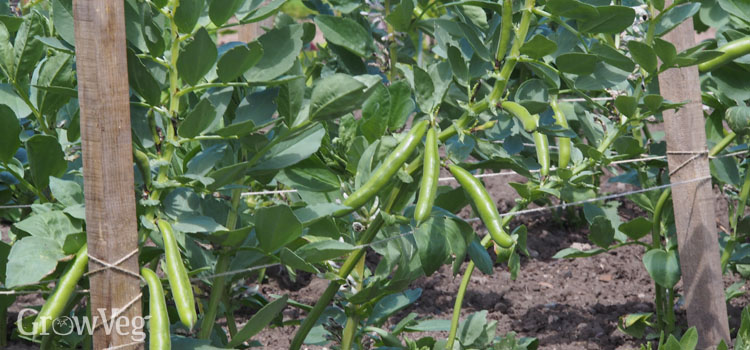
Pull out or carefully hoe off any weeds, especially while the plants are still young. Keep your beans watered in dry weather. Pests like chocolate spot and bean rust can quickly spread on plants that aren’t getting enough water, so make sure your plants get enough.
When the plants are fully bloomed and the first pods are set, we can also pinch off the very tips of the bean plants. These are the growing points. This makes it harder for black bean aphid colonies to form. They like this soft, new growth, so getting rid of it will make it less likely that they can take over your plants. This can also help to concentrate the plant’s efforts into pod formation. Don’t throw the tops away – you can eat them.
For those of you who have never smelled the flowers before, they have a delightfully sweet scent. And while we’re talking about flowers, there are some beautiful varieties with cerise flowers that you can grow.
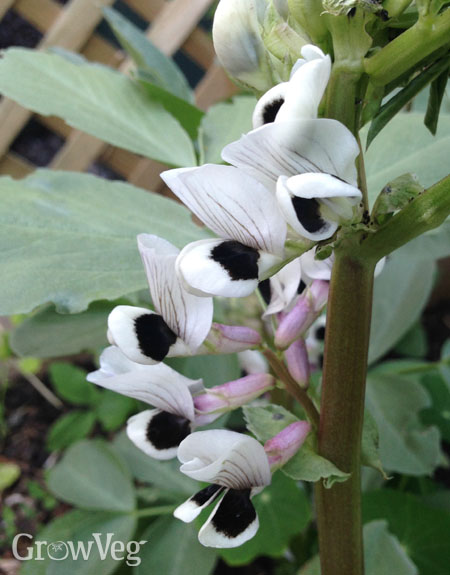
It’s very satisfying to pick full fava bean pods, just like it’s satisfying to dig up potatoes or pick the first ripe tomatoes. You can twist or pull them free, but be careful not to damage the stems.
You can eat smaller pods whole, but larger pods will need shelling. I really enjoy this process. The insides of the pods are so smooth and soft, almost like fur, and it’s so fun to slide out the fat, smooth beans. That is so fun and interesting to me! It’s also a great project for the kids to help with. Gluts are very easy to freeze.
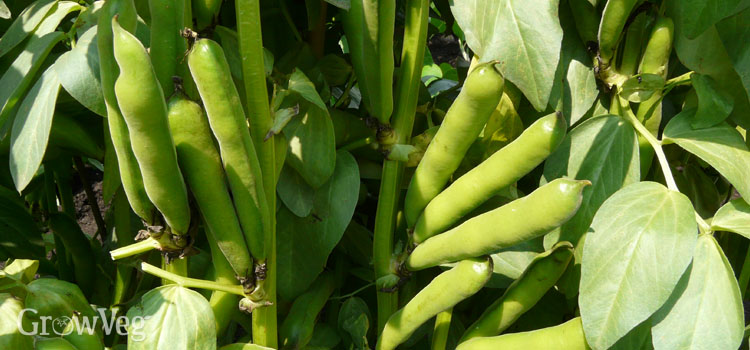
Cook smaller shelled beans as they are. Bigger, starchier beans need to be boiled for a few minutes so that you can pop off the thick skin and get to the soft inside.
Try steaming them and serve with a white sauce; whizz them up into a spring-fresh bean hummus, made zesty with a good squeeze of lemon juice; roast them with a little salt to snack on like peanuts; or perhaps, like all good cannibals, serve them up with some liver washed down with a nice chianti!
How to Plant Fava Beans
Fava beans, like all beans, work with bacteria in the soil to get nitrogen to their roots in the form of nodules, which are small balls. Nitrogen is an essential plant nutrient, so this remarkable setup makes these beans are pretty self-reliant. That being said, they will grow better if you add about 3 cm of compost to the soil before you plant them. You don’t have to dig it in; the worms will do it for you! The compost will help keep the soil healthy and draining, which means that plants will be healthy and productive.
Planting fava beans in the autumn gives the earliest-possible crop. They will also help keep the soil covered over the winter, which will keep soil life healthy, and they make good use of beds that would otherwise be empty. Pick a variety described as ‘hardy’ or specifically suited to autumn sowing.
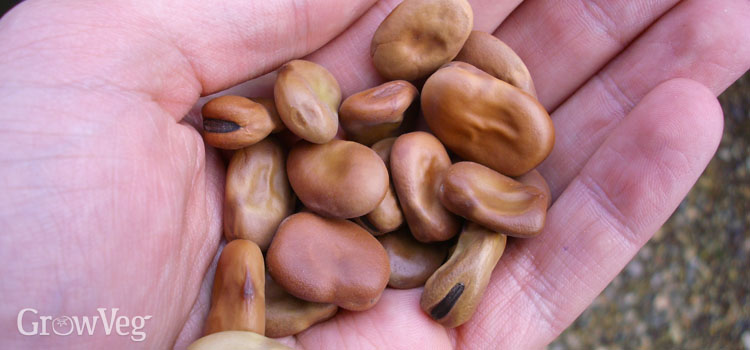
Fava beans are the biggest of all vegetable seeds, which makes them a lot easier to sow. You don’t have to mess around with tiny seeds trying to space them out. The easiest way to plant beans is to use a dibber or trowel to make holes for each one. There are a couple of ways you can space the seeds. Some people like to grow them in two rows, with about 3 feet (90 cm) between each pair of rows. I like to keep things simple, so I plant the seeds in a block 8 inches (20 cm) apart on each side and about 3 cm deep. Birds, like pigeons, can be a pain, so you might need to put some netting over the bed to keep them safe.
When you plant beans in the fall, you want them to sprout before winter, but if you plant them too early, they’ll grow quickly, softly, and long, only to be killed by the cold weather. Your seedlings should not be more than an inch or two tall before the winter, if possible. If seedlings get too big for their beds, you might want to use fleece or cloches to keep them warm when it gets cold.
For gardeners whose winters are too cold to plant seeds in the fall, or whose soil gets too wet to plant seeds in during the winter, either wait until spring to plant or protect the seeds in some way, like in a greenhouse or cold frame from mid- to late-winter.
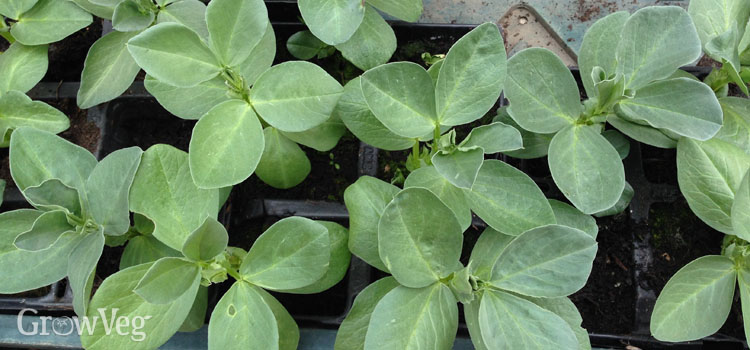
I like to plant fava beans in larger plug trays filled with all-purpose potting mix. I put one seed in each plug and make sure they all reach the same depth of about 3 cm (1 inch). Another option is to sow into small pots. If you plant seeds, don’t put them where mice can get to them. Mice have a strange way of finding seeds and digging them up. Unfortunately, mice have eaten many of my pea and bean seeds, so now I put them in a plastic storage tub with the lid on or wire mesh on top to keep the pests out. Mice can also find bean seeds outside, so this method may work best for you if you have a problem with them.
After the beans sprout, they can be grown in a greenhouse or cold frame until early spring, when they can be moved outside.
Broad bean seedling emerging (4K Timelapse)
FAQ
Do you pinch out broad bean seedlings?
What are the stages of the bean seedling?
|
Growth stage
|
Code
|
Description
|
|
0: Germination
|
09
|
Emergence: hypocotyl with cotyledons break through soil surface (“cracking stage”)
|
|
1: Leaf development
|
10
|
Cotyledons completely unfolded
|
|
|
12
|
2 full leaves (first leaf pair unfolded)
|
|
|
13
|
3rd true leaf (first trifoliate leaf) unfolded
|
How long does it take for a broad bean to sprout?
How long does it take for a bean to sprout in soil?
How long does it take a broad bean to grow?
Keep soil moist but never wet or dry. Seeds should germinate in around 7-14 days at a soil temperature of 6-24°C. Young seedlings will need protection from pests, pets and weather until they are established. Broad Bean plants may need watering during the growing season.
Are broad bean seeds easy to grow?
Broad bean seeds are a very easy type of vegetable seeds to grow. As such, they’re a favourite for beginners and experienced gardeners alike, producing a much superior flavour when homegrown as opposed to shop-bought. They are ideal for smaller spaces too, able to produce a high yield from a comparatively small size of plant.
How long does it take a broad bean to germinate?
Seeds should germinate in around 7-14 days at a soil temperature of 6-24°C. Young seedlings will need protection from pests, pets and weather until they are established. Broad Bean plants may need watering during the growing season. Water when the soil is dry about 5cm below the surface (test this by scratching away a little soil with your finger).
How do you grow broad bean seeds?
Take your broad bean seeds and soak them overnight in lukewarm water to soften the seed coat before planting. This will help speed up germination and ensure even growth. Another option is to pre-germinate the seeds by placing them on a damp paper towel in a sealed plastic bag. This encourages early sprouting before planting them in pots.
When should you plant broad bean seeds?
Sow your broad bean seeds under cover in February and March, when it’s still cold, and direct sow in the garden from March onwards. You can also sow them at the end of the year in September or October to overwinter and come into harvest two weeks ahead of your spring sown crop.
What type of soil do broad beans like?
Broad/Fava beans are very tolerant to the type of soil they grow in, though they prefer to be planted in soils that are deep and free draining. Most soils are perfectly adequate for broad beans as long as they are do not become water-logged. Broad beans have a preference for a sunny site that is not exposed to high winds.
- The Ultimate Guide to Growing Strawberries in Raised Beds - August 8, 2025
- No-Dig Garden Beds: The Easiest Way to Grow a Beautiful Garden - August 6, 2025
- How to Protect and Preserve Wood for Raised Garden Beds - August 6, 2025
